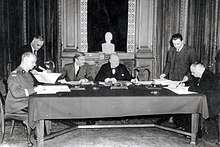Sikorski–Mayski agreement
The Sikorski–Mayski Agreement was a treaty between the Soviet Union and Poland, signed in London on 30 July 1941.[1][2][3] Its name is taken from its two most notable signatories: Polish Prime Minister Władysław Sikorski and Soviet Ambassador to the United Kingdom Ivan Mayski.

Background
After signing the German–Soviet Nonaggression Treaty in 1939,[4] the Soviet Union invaded Poland and took part in its subsequent dismemberment. The Soviet authorities declared Poland to be non-existent, and all former Polish citizens from the areas annexed by USSR were treated as if they were Soviet citizens. This resulted in the arrest and imprisonment of approximately 2 million Polish citizens (including a quarter of a million POWs and 1.5 million deportees[1]) by the NKVD and other Soviet authorities.
Negotiations
When the international situation of the Soviet Union changed with the German invasion in 1941, the Soviet dictator Joseph Stalin began to seek help from other countries opposing Germany. Strongly encouraged by British Foreign Secretary Anthony Eden, Sikorski, on 5 July 1941,[2][3] opened negotiations with the Soviet ambassador to London, Ivan Mayski, to re-establish diplomatic relations between Poland and the Soviet Union. Sikorski was the architect of the agreement reached by the two governments, signed on 30 July 1941. A further military alliance was signed in Moscow on 14 August 1941.[5][6] Later that year, Sikorski went to Moscow with a diplomatic mission[7] (including the future Polish ambassador to Moscow, Stanisław Kot, and chief of the Polish Military Mission in the Soviet Union, General Zygmunt Szyszko-Bohusz).
Provisions
Stalin agreed to declare all previous pacts he had with Nazi Germany null and void, invalidating the September 1939 Soviet-German partition of Poland and releasing tens of thousands of Polish prisoners-of-war held in Soviet camps. Pursuant to an agreement between the Polish government-in-exile and Stalin, the Soviets granted "amnesty" to many Polish citizens on 12 August 1941,[8][9] from whom a 40,000-strong army (Anders Army, later known as the Polish II Corps) was formed under General Władysław Anders. The whereabouts of thousands more Polish officers, however, would remain unknown for two more years, when it would weigh heavily on subsequent Polish-Soviet relations.
References
- Stanislaw Mikolajczyk The Pattern of Soviet Domination, Sampson Low, Marston & Co 1948, Page 17
- Jozef Garlinski Poland in the Second World War, ISBN 0-333-39258-2 Page 109
- The Fate of Poles in the USSR 1939~1989 by Tomasz Piesakowski ISBN 0-901342-24-6 Page 73
- Stanislaw Mikolajczyk The Pattern of Soviet Domination, Sampson Low, Marston & Co 1948, Page 4
- Jozef Garlinski Poland in the Second World War, ISBN 0-333-39258-2 Page 117
- Stanislaw Mikolajczyk The Pattern of Soviet Domination, Sampson Low, Marston & Co 1948, Page 18
- Stanislaw Mikolajczyk The Pattern of Soviet Domination, Sampson Low, Marston & Co 1948, Page 23
- The Fate of Poles in the USSR 1939~1989 by Tomasz Piesakowski ISBN 0-901342-24-6 Page 77
- Stanislaw Mikolajczyk The Pattern of Soviet Domination, Sampson Low, Marston & Co 1948, Page 19
External links
- (in Polish) Text of the treaty
- (in English) Polish-Soviet Union Agreements : July 30, 1941